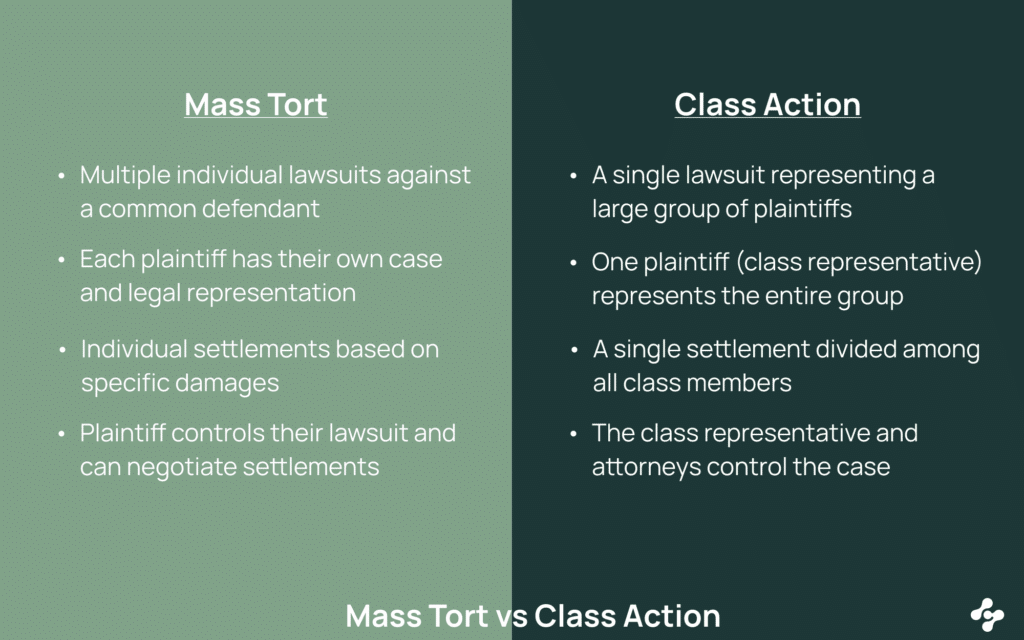When multiple people are harmed by the same defective product, medical device, or corporate misconduct, they often seek justice through legal action.
Two common approaches are mass tort lawsuits and class action lawsuits. While both involve numerous plaintiffs with similar claims against a common defendant, they differ in how cases are handled, how plaintiffs are represented, and how compensation is awarded. Understanding the primary difference between these legal actions is essential for individuals considering a lawsuit.
What is a mass tort case?
A mass tort action involves multiple lawsuits with individual plaintiffs who suffered harm from the same defective medical device, pharmaceutical company, or airplane crash. Unlike class action suits, each mass tort claim is handled separately, though cases may be grouped together in multidistrict litigation (MDL) to streamline the litigation process.
- Each injured party files a separate lawsuit.
- Compensation is determined individually based on damages.
- Often used in medical device failures, defective drug injuries, and toxic exposure cases.
What is a class action lawsuit?
A class action lawsuit consolidates multiple similar claims into a single lawsuit against a common defendant. Instead of each individual plaintiff filing separately, a representative plaintiff (also called a class representative) sues on behalf of all affected parties, known as class members.
- One class representative makes legal decisions for the entire class.
- A single lawsuit determines the outcome for all class members.
- Commonly used in product liability cases, defective drugs, or large corporation misconduct.
Key takeaway
While both lawsuits address similar grievances, a class action suit treats all claims as one, while mass tort litigation allows each plaintiff to pursue an individual case.
Who controls the legal process?
Mass tort actions
In mass tort litigation, each individual plaintiff controls their individual lawsuit, allowing for more tailored legal strategies. Courts often group cases into multi-district litigation (MDL) for efficiency, but each lawsuit remains distinct.
- Plaintiffs can negotiate their own settlements.
- Compensation varies based on injuries, medical costs, and damages.
- Cases may be filed in state or federal court, depending on jurisdiction.
Class action lawsuits
In a class action lawsuit, the representative plaintiff and their attorney manage the case on behalf of the class members. Individual class members do not have control over the legal proceedings but receive a share of any settlement or verdict.
- Plaintiffs are automatically included unless they opt out.
- Settlements or court decisions apply to the entire class.
- The case is handled in federal court if it meets jurisdictional requirements.
Key takeaway
A class action is controlled by a single lawsuit, while a mass tort case gives each injured party a say in their legal proceedings.
Compensation and resolution differences
Mass tort settlements
Since mass tort claims are handled individually, compensation is based on each plaintiff’s damages. Plaintiffs may receive higher settlements than in class action lawsuits, particularly in cases involving severe personal injury.
- Typically seen in cases of defective medical device injuries, airplane crashes, and toxic exposure cases.
- Settlements reflect the severity of harm each individual plaintiff endured.
Class action settlements
In a class action suit, compensation is divided among all class members, often resulting in smaller payouts per individual.
- Common in product liability, defective drug, and corporate fraud cases.
- Settlements must be approved by the court.
Key takeaway
Mass tort cases result in individual settlements, while class action lawsuits distribute a single settlement across all class members.

Mass tort and class action cases in real life
Mass tort
The silicone breast implant lawsuits of the 1990s are a classic example of mass tort litigation. Patients who suffered severe health complications due to faulty implants from companies like Dow Corning filed individual lawsuits against the manufacturers.
- Unlike a class action, each individual plaintiff presented their own medical records, injuries, and damages.
- The cases were consolidated into multidistrict litigation (MDL) to streamline legal proceedings.
- Dow Corning eventually reached a $3.2 billion settlement to compensate victims, but payouts varied based on each plaintiff’s injuries.
Class action lawsuit
In 2015, Volkswagen (VW) faced a massive class action lawsuit after it was revealed that the company had installed software in diesel vehicles to cheat emissions tests. This class action suit involved hundreds of thousands of vehicle owners who purchased cars under false pretenses, believing they were environmentally friendly.
- The class members were grouped together in a single lawsuit.
- Volkswagen paid over $14.7 billion in settlements to compensate vehicle owners and address environmental damages.
- Plaintiffs received financial compensation based on the vehicle model and damage caused by the fraud.
Other notable cases
Tobacco Litigation (Mass Tort)
Multiple lawsuits were filed against tobacco companies, with plaintiffs seeking damages for health issues caused by smoking. Unlike a class action lawsuit, these cases were handled individually, leading to billions in settlements over the years.
Enron Securities Fraud (Class Action)
Following Enron’s corporate fraud scandal, investors filed a class action lawsuit for financial losses due to fraudulent accounting. The lawsuit resulted in $7.2 billion in settlements for affected shareholders.
Key Takeaway
A class action lawsuit works best when similar claims and damages are shared by a large group, like financial fraud victims or defrauded consumers. In contrast, mass tort cases are ideal when individual plaintiffs have varying levels of harm, such as personal injuries from defective medical devices or tobacco-related illnesses.
Choosing the Right Legal Action for Your Case
If you or a loved one has suffered harm due to a defective product, defective drug, or medical device, it’s crucial to choose the right type of legal action.
- If your claim is like thousands of others with identical/similar damages, a class action lawsuit may be the best approach.
- If your personal injury case involves distinct differences in damages, a mass tort claim can ensure fair compensation.
- Seeking a free consultation with an experienced attorney can help determine whether a mass tort lawsuit or class action lawsuit is right for you.
The right legal approach—and the right tools to manage it
Both mass tort actions and class action suits provide legal pathways for plaintiffs seeking justice against large corporations, pharmaceutical companies, and defective products.
Understanding the procedural differences and potential compensation can help plaintiffs and their attorneys make informed decisions. If you’re unsure which legal proceeding applies to your case, consult with an experienced attorney to explore your options and pursue the justice you deserve.
For personal injury attorneys, managing mass tort cases and class action lawsuits can be complex. That’s where CloudLex comes in. As the leading cloud-based case management software designed exclusively for personal injury law firms, CloudLex helps attorneys streamline workflows, manage cases efficiently, and collaborate seamlessly.
With features like client intake, document management, calendaring, and secure communication, CloudLex ensures that personal injury attorneys can focus on winning cases and serving clients. Built with HIPAA-compliant security and thoughtful integrations, CloudLex simplifies legal operations—whether you’re handling individual lawsuits, mass tort claims, or class action suits. Contact us to learn more or request a demo today!

